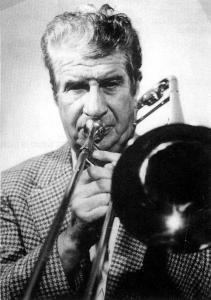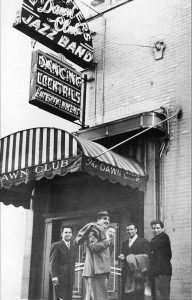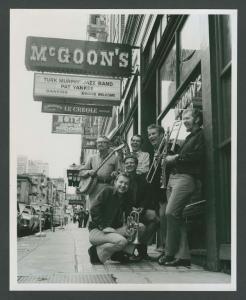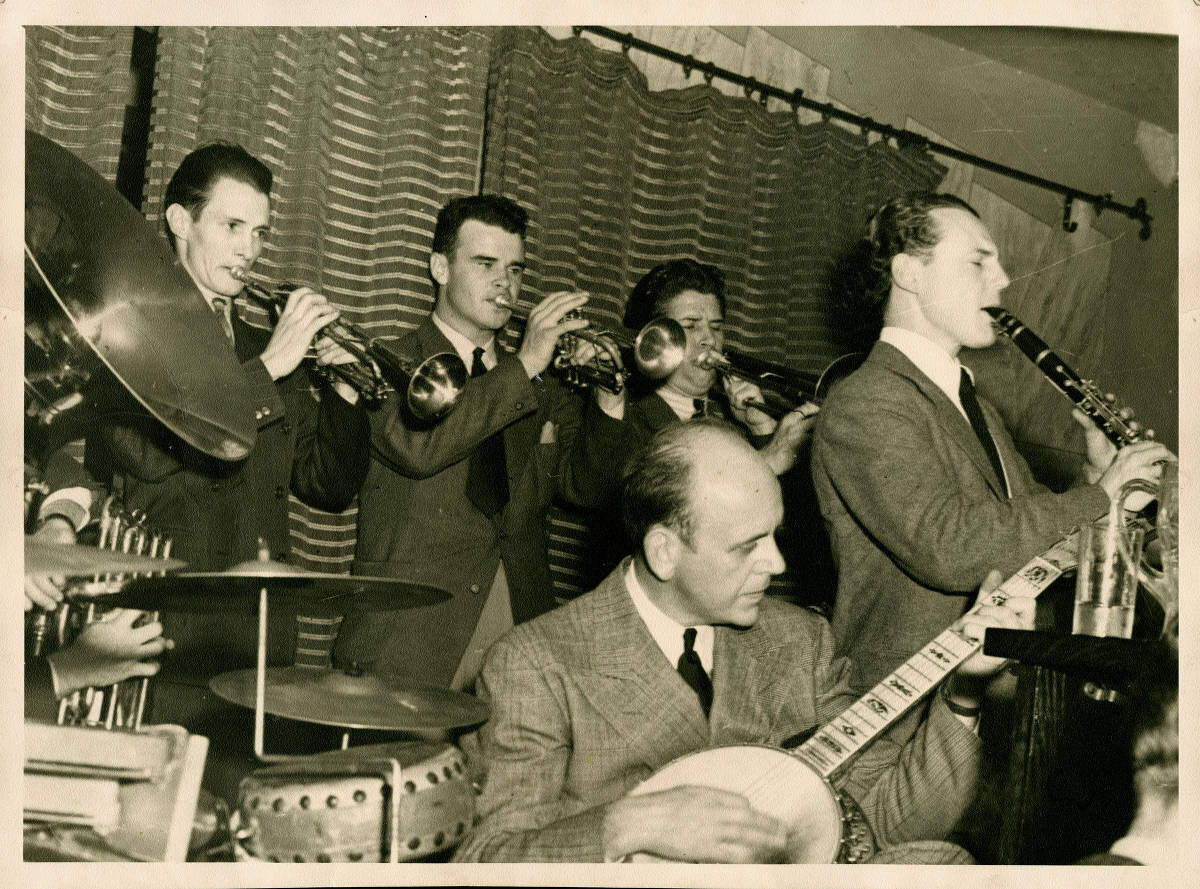 I first heard Turk Murphy’s band back in my sportswriting days when I was in Cleveland, Ohio, to cover a college football game in 1949. As I wandered about downtown Cleveland the night before the game, I heard a musical sound I have never heard before coming from an open door leading to the lounge of the Hotel Auditorium, which has long-since been demolished.
I first heard Turk Murphy’s band back in my sportswriting days when I was in Cleveland, Ohio, to cover a college football game in 1949. As I wandered about downtown Cleveland the night before the game, I heard a musical sound I have never heard before coming from an open door leading to the lounge of the Hotel Auditorium, which has long-since been demolished.
It was the distinctive sound of the Murphy band perched precariously on a small bandstand above the bar. Years later when I related this memory to Turk, he recalled, “The bandstand was so small that we had to lean against each other to prevent falling off the stage.”
Melvin Edward Alton “Turk” Murphy is acknowledged by many as the founding father of the West Coast traditional jazz revival, although some people may feel that honor belongs to or should be shared with Lu Watters. I view Turk’s longevity—40 years of sustained performance vs. seven for Watters’ Yerba Buena band (of which Murphy was a member)—as having a greater impact on the music of that period.
Turk grew up in the north-central California farming community of Palermo. When he was 19, he joined the Merle Howard Orchestra where he met Bob Helm, who was in the reed section. The next year (1935) saw him with the Val Bender Orchestra in Texas and then Will Osborne’s big band where he recorded for the first time. He had another stint with a big band (Mal Hallett) before returning to the Bay Area to play Dixieland gigs with Bob Helm.
Yerba Buena Jazz Band
Pianist Paul Lingle introduced Turk to Lu Watters in 1938 and shortly thereafter, along with Bob Helm, they formed a small jazz band that eventually became the Yerba Buena Jazz Band that held forth at the Big Bear Tavern in the Oakland hills across the bay from San Francisco. Following military service in World War II, the band reformed in 1946.

“We were all professional musicians and were making a living,” Turk said in a 1987 interview. “But we weren’t satisfied with what we were doing. We could do casual work and commercial jobs for the rest of our lives, but we were young and full of fire. We thought we should take one long shot at something that needed a shot—the New Orleans jazz of King Oliver, Louis Armstrong and Jelly Roll Morton, which nobody was playing then. So we started this do-or-die attempt to revive the music.”
It was at the Dawn Club on Annie Street, behind the Palace Hotel in San Francisco, that the band became a magnet for traditional jazz fans from far and near before and right after World War II. Watters teamed with Bob Scobey to emulate the two-cornet combo of King Oliver and Louis Armstrong in Oliver’s Creole Jazz Band from the 1920s. The band was soon getting offers from the East Coast and Europe, but Watters was reluctant to travel. So in 1949, Turk left the band and formed his own group that initially was known as the Bay City Stompers. But he was told that his name would be more recognizable, so the band henceforth was always the Turk Murphy Jazz Band.
10 Years on the Road
During the 1950s, the band was rarely in San Francisco. For three years, it was based in New York City where they played all the popular clubs of the day such as The Roundtable, Embers and Basin Street East. At The Embers, which was a long narrow room with a small bandstand, and tables jammed tightly together, Turk recalled, “We had to stuff rags in our horns to avoid offending people who wanted to carry on conversations at tables right under the band.”
K.O. Eckland, in his Jazz West book, wrote, “Despite continual personnel changes, which was typical of bands with such demanding schedules, Murphy retained the integrity of his own sound due to his rigid structuring of the basic music, and by developing his own library of ensemble arrangements.”

By 1960, Turk and his musicians were tired of travel and returned to San Francisco where Turk opened his own club, taking the name from Al Capp’s comic strip, Li’l Abner— Earthquake McGoon’s. When Turk asked for permission to use the name, the cartoonist replied, “I hereby give you permission to use the name Earthquake McGoon as long as you play good jazz and keep your nose clean.” The band became such a SFO fixture that McGoon’s was even included on tourist bus routes.
During the next 24 years, there were four different Earthquake McGoon’s. Turk lamented, “They kept tearing them down and replacing them with monuments. They were never monuments to me. They didn’t consider me monumental.” In later years, the band could usually be found at the New Orleans Room of the San Francisco Fairmont.
Turk the Prankster
Turk had quite a reputation as a prankster as evidenced when he was best man at Linda and Bob Schulz’s wedding in the summer of 1981. The ceremony was to take place in the yard of Linda’s parents’ home under a stately oak tree. As the ceremony proceeded, the minister intoned, “If anyone here objects to this union, speak now or forever hold your peace.” Bob realized something was up because that phrase wasn’t usually included in most wedding ceremonies.
Suddenly, over the hill and down the driveway roared a 1920s convertible roadster loaded with some McGoon patrons known as the Lato Mob, dressed in ’20s attire and firing toy machine guns. They jump out of the car shouting, “Stop the wedding. Dutch Schultz is wanted by the authorities in Chicago.” They produce an actual photo of Schultz the gangster, which fortunately bore little resemblance to Schulz the bridegroom. This performance was obviously setup by Turk, and instantly changed the seriousness of the occasion.
Impressive Band Alumni
The list of alumni from the Turk Murphy Jazz Band reads like a who’s who of West Coast musicians. From the early days: Bob Helm, Dick Lammi, Wally Rose, Harry Mordecai, Bob Short, Don Kinch, Clancy Hayes, and Pat Yankee. Among those who followed were Pete Clute (who also co-owned McGoon’s), Bill Carroll, Carl Lunsford, Monte Ballou, Bob Neighbor, Leon Oakley, Jim Maihack, Ray Skjelbred, Bob Schulz, John Gill, and many others who deserve to be listed.

Turk is the subject of several books that are still available through Amazon. His discography lists over 40 albums. The band appeared on the Ed Sullivan TV Show twice, and Turk sang as a character in two 1971 Sesame Street cartoon shorts. Turk Murphy Day was twice proclaimed by San Francisco mayors—1974 and 1987, the later in connection of band’s sold-out appearance at Carnegie Hall. Turk at the time had been diagnosed with bone cancer and was undergoing chemotherapy. It was to be his last public appearance, and he passed away on May 30, 1987 at the age of 71.
Turk took pride that in 39 years, the kind of music the band played never changed. “Of course, our repertory changes,” he said. “We drop tunes, and we add tunes. But they’re all along the same lines. We pay our respects to the people for whom we have respect—Oliver, Morton, Armstrong, all the early players.”
Lew Shaw started writing about music as the publicist for the famous Berkshire Music Barn in the 1960s. He joined the West Coast Rag in 1989 and has been a guiding light to this paper through the two name changes since then as we grew to become The Syncopated Times. 47 of his profiles of today's top musicians are collected in Jazz Beat: Notes on Classic Jazz.Volume two, Jazz Beat Encore: More Notes on Classic Jazz contains 43 more! Lew taps his extensive network of connections and friends throughout the traditional jazz world to bring us his Jazz Jottings column every month.






















